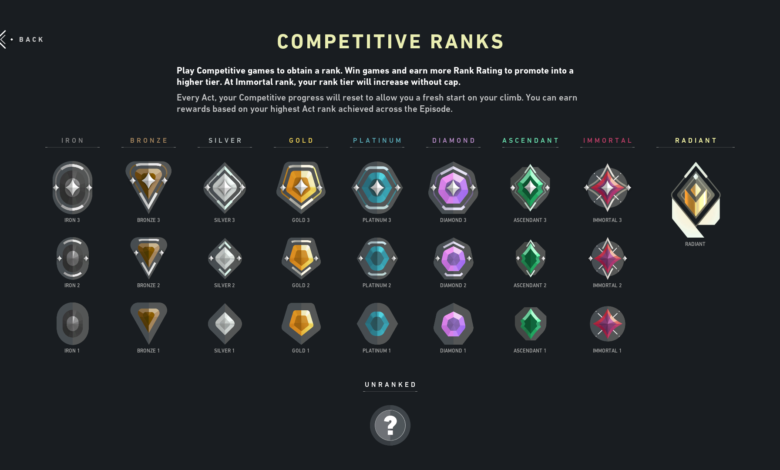Understanding Valorant Rank: A Comprehensive Guide

Introduction to Valorant Rank
In the world of competitive gaming, rank serves as a crucial indicator of a player’s skill and experience, and this holds true in the popular tactical shooter, Valorant. Valorant rank is a metric that categorizes players based on their performance in matches, directly influencing their matchmaking experience and the quality of opponents they face. Each player starts in the unranked tier, and as they engage in competitive matches, a series of wins or losses will determine which rank they will eventually achieve.
The importance of ranks in Valorant cannot be overstated. Ranks serve as both a personal achievement and a tool for the matchmaking system to create balanced games. A player’s rank not only reflects their individual capabilities but also informs teammates and opponents of their expected performance level. This is essential for maintaining a fair and engaging competitive environment, where players aspire to climb the ranks while honing their skills.
Valorant employs a tiered ranking system, ranging from Iron, Bronze, Silver, Gold, Platinum, Diamond to Immortal and Radiant. These tiers are further subdivided into divisions, providing a granular view of a player’s progress. Upon reaching a new rank, players may experience challenges and adjustments as they encounter opponents of equal skill, which requires continual improvement and adaptation. Progressing through these different ranks is not merely about winning; it entails understanding game mechanics, strategic team play, and effective communication.
As players ascend in rank, they can expect an increase in the overall skill level of their matches, making victories more rewarding yet challenging. The pursuit of a higher Valorant rank motivates players to refine their techniques, knowledge, and coordination, enriching their gaming experience and community involvement.
Understanding Valorant’s Ranking System
The Valorant ranking system is designed to provide players with a competitive environment that reflects their skill level accurately. Central to this system is the Matchmaking Rating (MMR), a numerical value that signifies a player’s skill and performance in matches. The MMR is primarily affected by the outcomes of the games played; winning matches generally causes a player’s MMR to increase, while losses typically lead to a decrease. This dynamic nature ensures that players are matched against others of comparable skill levels, which is essential for maintaining fairness and competitiveness in the game.
Each player is placed into one of several ranks, ranging from Iron to Radiant, with multiple tiers within each rank. The exact placement is influenced by an individual’s MMR and performance in ranked matches. The rank a player sits in reflects their ability and consistency, with promotions and demotions occurring based on MMR changes. For instance, if a player consistently performs well and increases their MMR significantly, they may be promoted to a higher rank. Conversely, a decline in performance can result in a demotion to a lower rank. This system encourages players to continually improve their skills and strategically adapt to the evolving competitive landscape.
Several factors can impact a player’s rank changes beyond just wins and losses. These include individual performance metrics such as kills, assists, and deaths, as well as the performance of teammates in a given match. Players who excel in key performance indicators can experience faster rank progress, while underperformance may slow their ascent or result in rank loss. Understanding these nuances of the Valorant ranking system allows players to navigate their competitive journey more effectively and work towards achieving their desired valorant rank with informed strategies.
The Different Ranks in Valorant
Valorant, developed by Riot Games, features a structured ranking system that categorizes players into various tiers based on their skills and performance. This system not only serves to match players accordingly in competitive play but also helps individuals gauge their progress over time. The ranks range from Iron, the entry-level, to Radiant, the pinnacle of achievement in Valorant.
Starting with Iron, this rank represents the initial threshold of competitive play. Players in the Iron tier often possess basic knowledge of game mechanics but may lack overall experience and skill refinement. Following Iron is Bronze, where players showcase an improved understanding of gameplay but still have a lot to learn about strategies and teamwork.
Moving up, Silver rank players typically demonstrate a better grasp of the game’s fundamentals. They usually possess a solid understanding of gunplay and map awareness, contributing positively to their team’s performance. The Gold rank signifies a higher proficiency in gameplay, where players not only excel in individual skills but also begin to understand more advanced strategies and communication skills.
Next is Platinum, a rank that represents players who have honed their skills and can consistently perform well. In this tier, individuals are often more reliable in executing strategies and can adapt their gameplay to different circumstances. Diamond rank players are generally very competitive, showing exceptional skill and game sense, often leading their teams to success through effective decision-making and collaboration.
As players progress further, they may attain Immortal rank, which highlights individuals who dominate in both personal performance and teamwork, consistently displaying high levels of skill. Lastly, the Radiant rank epitomizes the best players in the game, with only a small percentage achieving this prestigious level, representing unparalleled skill and expertise in Valorant.
Tips for Climbing the Valorant Ranks
Climbing the Valorant ranks requires a well-rounded approach that combines individual skill improvement, effective teamwork, and strategic communication. One of the fundamental aspects of enhancing your performance is to focus on your gameplay mechanics. Spend time in the shooting range to familiarize yourself with different weapons and practice your aim. Consistent practice is essential, as it helps players develop muscle memory, which can be crucial during the heat of a match.
Another important factor lies in mastering the agents you choose to play. Understand their abilities thoroughly and learn how to utilize them effectively in various situations. By specializing in a handful of agents, you can gain a deeper understanding of their strengths and weaknesses, enabling you to contribute more significantly to your team’s overall performance in ranked matches.
Teamwork is critical in Valorant, so cultivate good relationships and clear communication with your teammates. Use voice chat or text chat to share information about enemy positions, strategies, or other necessary updates during the game. Developing a strategy as a team prior to each match can significantly increase your chances of securing victories and climbing the Valorant ranks.
Additionally, learning from your losses is crucial. After each match, take the time to review your gameplay. Identify areas where you or your team may have underperformed and consider what alternative actions could have led to better outcomes. This reflective practice can be instrumental in recognizing patterns in your gameplay that require improvement.
Finally, ensure that you are playing regularly. Just like any other competitive skill, consistency is key. The more you play, the more you will understand the game’s nuances, and with persistence, you will find yourself steadily rising through the ranks of Valorant.
Common Mistakes That Hold Players Back
In the competitive landscape of Valorant, players often encounter a variety of challenges that can impede their progression in rank. Understanding these mistakes is key to enhancing one’s performance and achieving desired ranks. One of the most prominent errors players make is poor positioning. In Valorant, positioning is fundamental to both offensive and defensive strategies. Being in the right location allows players to maximize their effectiveness, leveraging cover and angles to outmaneuver the enemy. A failure to position properly can lead to unnecessary deaths and lost rounds, ultimately resulting in a lower Valorant rank.
Another critical factor is a lack of game sense. Game sense encompasses an understanding of timing, map control, and enemy behaviors. Players who struggle to develop their game sense may find themselves out of sync with the flow of the match, leading to poor decision-making. For instance, engaging enemies without adequate knowledge of their location can result in disastrous encounters. Therefore, honing one’s awareness and anticipating opponents’ actions can significantly improve a player’s rank progression in Valorant.
Effective communication with teammates also plays a pivotal role in a player’s success. Valorant is inherently a team-based game, and not utilizing voice chat or in-game notifications can create a disjointed team dynamic. Players need to convey essential information, like enemy positions or strategical plans, to coordinate attacks and defenses. Furthermore, not adapting to the current meta can hinder players’ ability to climb the ranks. Valorant continually evolves, and staying informed about changes in agent strengths, weapon performance, or map dynamics is vital. Failing to adjust one’s playstyle in accordance with the meta can result in ineffective gameplay, impacting overall ranking potential.
The Role of Team Composition in Ranking
A significant factor influencing your valorant rank is your team’s composition. In a game that rewards collaboration and strategy, having a balanced team can substantially impact your chances of success and, consequently, your ranking progression. Each agent in Valorant possesses unique abilities, and selecting agents that complement each other can create a synergistic effect, enhancing overall team performance.
A well-rounded team typically consists of Duelists, Controllers, Sentinels, and Initiators. This diversity allows players to implement various strategies, adapting to the evolving dynamics of the game. For instance, a Duelist can enter the fray and secure early eliminations, while a Controller can manage the battlefield, providing crucial map control through smoke and utility. Meanwhile, Sentinels can focus on healing and securing flanks, while Initiators can create openings by disrupting enemy defenses. Ensuring that your team includes these essential roles can pave the way for smoother victories and an upward trajectory in your valorant rank.
Furthermore, communication remains paramount in orchestrating strategic plays. Teams that effectively communicate their strategies, including agent choices and tactical executions, tend to perform better. Coordination among players leads to improved synergy and maximizes the potential of each agent’s abilities. Achieving a high valorant rank demands not just individual skill but also an acute understanding of how each role contributes to the team’s objectives. Teams that recognize the significance of composition and strategy are more likely to secure victories, reflecting positively on their rank progression.
To optimize your chances of elevating your valorant rank, focus on playing within a balanced team structure, promoting communication among teammates, and exploiting the strengths of each agent. Ultimately, the interplay of these elements can greatly influence your ranking journey in Valorant.
Understanding the Importance of Game Sense and Mechanics
In the competitive environment of Valorant, possessing strong game sense and mechanical skills is crucial for players aiming to enhance their valorant rank. Game sense encompasses the ability to read the current situation effectively, anticipate enemy movements, and make strategic decisions based on available information. Meanwhile, mechanics refer to the player’s physical skills, such as aiming precision and movement control, which play a significant role in achieving success within the game.
Aiming is perhaps the most critical mechanical skill a player can develop in Valorant. A player’s efficiency in landing shots directly impacts their performance. Regular practice through aim trainers or in-game shooting ranges can significantly enhance a player’s accuracy, leading to improved kill counts and a higher likelihood of winning duels, which in turn can facilitate ascendance within the valorant rank structure.
Map awareness is another vital component of game sense. Familiarity with the map allows players to navigate effectively, anticipate choke points, and understand typical enemy routes. Knowing the intricacies of each map aids players in making informed decisions during gameplay, such as when to engage or retreat. Furthermore, understanding the timings of when to execute strategies, such as when to push or hold back, enhances a player’s overall tactical approach.
Moreover, understanding enemy movements and utilizing that knowledge is pivotal in achieving favorable outcomes. By recognizing common patterns of play among opponents, players can position themselves more advantageously, leading to better engagements and increased odds of winning encounters. Quick and effective decision-making is also paramount in this regard. Players are constantly required to make split-second judgments, often determining the outcome of an engagement. The combination of sharp mechanics and sound game sense forms the foundation for elevating one’s valorant rank and succeeding in competitive play.
Utilizing Guides and Resources for Improvement
Improving one’s Valorant rank can be a challenging yet rewarding endeavor. To overcome obstacles and accelerate progress, aspiring players can benefit significantly from a variety of online guides and community resources. Numerous platforms offer great materials designed to address different aspects of gameplay, ensuring a well-rounded improvement trajectory.
One of the primary resources is video guides available on platforms like YouTube. Several skilled players and content creators share their experiences, strategies, and techniques that cater to various skill levels. These videos often provide visual demonstrations of game mechanics, character abilities, and situational decision-making, which are vital for enhancing one’s gameplay. By watching higher-ranked players, users can assimilate knowledge of advanced tactics to elevate their own Valorant rank.
Additionally, written guides from reputable websites such as Liquipedia and the official Valorant blog offer extensive insights into maps, agent selections, and overall game strategies. These articles typically feature expert tips, character guides, and in-depth analyses of game updates, ensuring players remain informed of the evolving meta. Moreover, these resources often discuss fundamental concepts like communication and teamwork, which are essential for improving performance in matches.
Another effective way to gather insights is by engaging with the Valorant community on platforms such as Reddit and Discord. These forums enable players to discuss strategies, ask questions, and share personal experiences. Connecting with higher-ranked players in these communities can provide valuable advice that is tailored to individual weaknesses. Learning from their experiences can facilitate a more personal approach to improvement, ultimately assisting players in ascending the ranks.
Taking advantage of these various guides and resources not only enhances the understanding of game mechanics but also fosters a sense of community among players. Through continuous learning and practice, players equipped with the right tools can expect to see their Valorant rank improve over time.
Setting Realistic Goals for Valorant Ranking
Achieving a high valorant rank can be a compelling pursuit for many players, yet the desire for success can sometimes overshadow the importance of setting realistic and achievable goals. One of the pivotal aspects of enhancing your performance in Valorant is to shift the focus from merely chasing a specific rank to personal development and skill enhancement. This approach encourages players to embrace the journey of improvement, allowing for a more fulfilling experience.
To begin with, players should assess their current skill level and identify specific areas for growth. This involves not only understanding one’s strengths but also recognizing weaknesses that may hinder progression through the ranks. By concentrating on aspects such as game mechanics, map knowledge, and teamwork, players can establish well-defined objectives that align with enhancing their overall gameplay. For instance, if a player struggles with accuracy, setting a target to practice aiming techniques for a week can translate into real ranking benefits over time.
Additionally, it is essential to celebrate small wins as significant milestones rather than focusing solely on the end goal of achieving a higher valorant rank. These incremental achievements can include mastering a new agent, executing a clutch play, or effectively communicating with teammates. Acknowledging these successes fosters a positive mindset, which is crucial in a competitive environment like Valorant.
Furthermore, maintaining a balance between competitive play and personal enjoyment is vital. While striving for a higher rank is motivational, let it not be the sole metric of success. Engaging with the game as a means of creative expression or a way to unwind with friends can lead to a more enjoyable experience, ultimately reflecting positively on a player’s performance. As players adopt this comprehensive approach, they are likely to witness steady progression in their valorant rank, reinforcing the connection between enjoyment and improvement.
You May Also Read This Dailytimenews.




